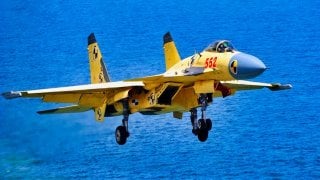China's J-15 Aircraft Carrier Fighter Plane Has Strange Origin: Ukriane

After failed attempts to procure Russia's Sukhoi Su-33—due to disputes over intellectual property and procurement terms—China reverse-engineered the Su-33 using a prototype obtained from Ukraine, leading to the development of the J-15.

After failed attempts to procure Russia's Sukhoi Su-33—due to disputes over intellectual property and procurement terms—China reverse-engineered the Su-33 using a prototype obtained from Ukraine, leading to the development of the J-15.
-Initially powered by Russian engines, the J-15 now uses China's WS-10B engines, claimed to offer better performance. While China asserts the J-15 outperforms the U.S. F/A-18 Super Hornet in certain aspects, these claims are debated. Regardless, the J-15 symbolizes China's growing military ambitions.
AfriPrime App link: FREE to download...
https://www.amazon.com/Africircle-AfriPrime/dp/B0D2M3F2JT
J-15 Flying Shark: China's Reverse-Engineered Carrier Fighter from Ukraine
Known as the Flying Shark, the Shenyang J-15 is a carrier-based multirole fighter currently in service with the People’s Liberation Army Navy. The J-15, of which sixty have been built, is further indication of China’s commitment to expanding its naval capabilities as she continues to assert herself more forcefully throughout the Indo-Pacific.
Russian friction
China spent years working to procure a carrier-based fighter from the Russians, the Sukhoi Su-33. The bid failed, as Moscow tells the story, when Russia learned that China had ripped off the blueprints of another Russian jet, the Sukhoi Su-27SK, to create a Chinese-derivative.
The Su-27SK derivative was known as the J-11B and incited Russia, who claimed that China had violated intellectual property agreements between the two nations. China tells a different story, however; according to China, the Su-33 procurement attempt failed when Russia demanded a minimum order of 50 Su-33s, with a payment sufficient to cover the high cost of reopening the Su-33’s defunct production lines.
He said, she said. Whatever happened, the Chinese moved on from their attempts to buy the Su-33, and instead, the did what they often do: relied on reverse-engineering.
Hospital Management Platform SaaS.. Hospital and Patients management system perfect for all medicals.
Partnership/Agent Needed. Earn As You Go on monthly basis.
Contact Admin: admin@healthdata101.com
+++++++++++++++++++++++++++++++++++++++++++++++++++++
Reverse Engineering
To reverse engineer the Su-33, the Chinese relied upon an Su-33 prototype that had been procured from Ukraine. The result was the J-15, whose prototype debuted in 2009, and made its first ski-jump takeoff in 2010. Granted, the ski-jump wasn’t on a carrier, but rather had been constructed on land, where the stakes were lower, and the margins for error higher, but still, the test served as a proof of concept. The J-15 was tested from an actual aircraft carrier in 2012, during a deployment from the Lianoning.
In addition to the ski-jump takeoffs, the J-15 was outfitted to perform catapult launches, too. As such, the J-15 is built strong, to withstand the structural stress of carrier takeoffs and landings. Still, the J-15’s airframe was built predominantly from composite materials for the purpose of saving weight and improving performance.
Originally, the J-15 had been built with a Russian Saturn AL-31 turbofan engine. But in 2022, the J-15 appeared with a Chinese-made WS-10B engine. According to the Chinese, their homegrown engine was better than the Russian Saturn, offering improved safety, reliability, and service life.
J-15 Performance
The J-15 does perform admirably. While Chinese assessments, that the J-15 “exceeds the aerodynamic capabilities of virtually any fighter aircraft currently operated by regional militaries, except for the U.S. F-22 Raptor,” may be overblown, the J-15 does have a ten percent greater thrust-to-weight ratio, and 25 percent better wing loading, than the closest American equivalent – the F/A-18 Super Hornet. And the Chinese have not been shy about claiming that the J-15 is a superior aircraft to the Super Hornet, at least with respect to bomb load, combat radius, and mobility, if not with respect to electronic and combat systems.
Either way, the J-15 is an indication of China’s budding military ambitions.
AfriPrime App link: FREE to download...
- Questions and Answers
- Opinion
- Story/Motivational/Inspiring
- Technology
- Art
- Causes
- Crafts
- Dance
- Drinks
- Film/Movie
- Fitness
- Food
- Games
- Gardening
- Health
- Home
- Literature
- Music
- Networking
- Other
- Party
- Religion
- Shopping
- Sports
- Theater
- Wellness
- News
- Culture
- War machines and policy

